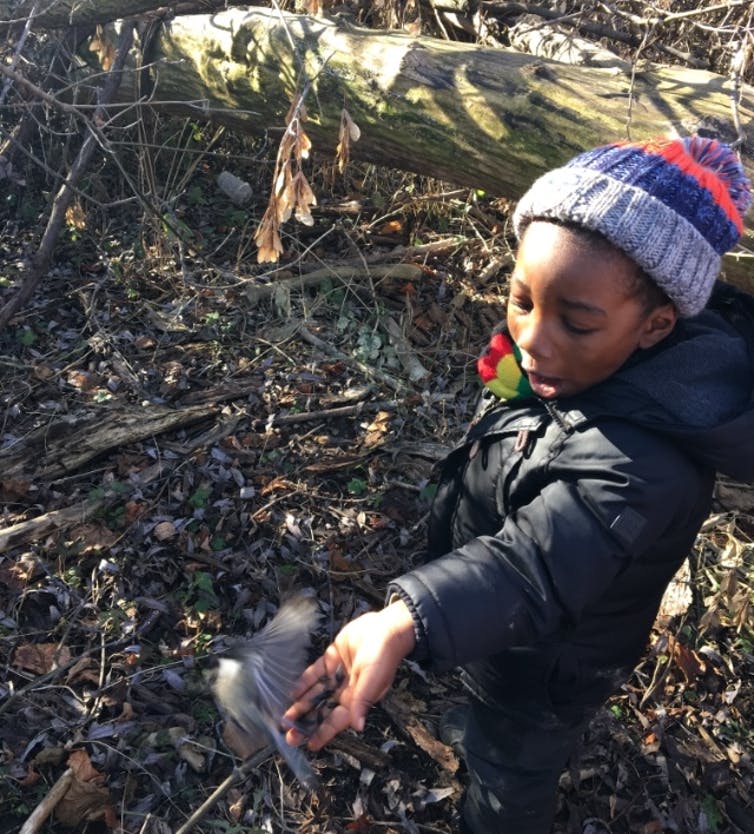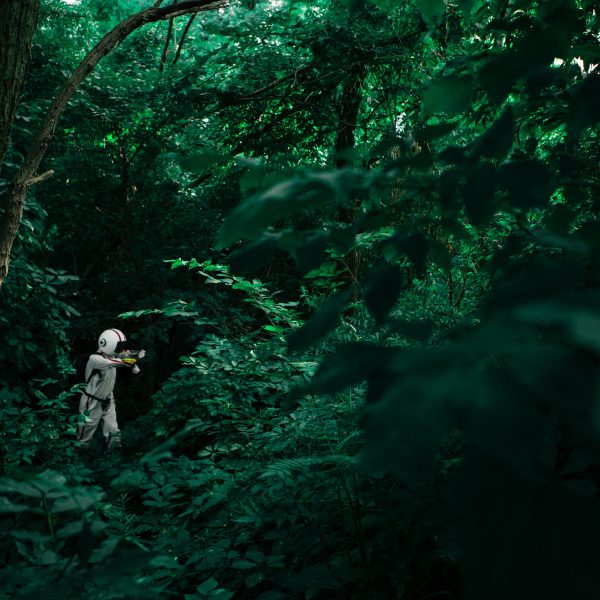Wonder and wisdom in a children’s forest nature program

On a windy autumn morning, children dressed in colourful woolly hats and mittens sing a greeting to the Earth near a towering 150-year-old willow tree.
Children notice how the wind and sun play with the tree. They wonder what is happening inside; they offer sticks for the tree to eat and investigate the inside cracked open after a wind storm.
The deeply furrowed trees provide opportunities for climbing and a bird’s eye view of adventures below. Hungry chickadees call out as they swoop from branches, landing on outstretched hands that offer shiny sunflower seeds. The children shout with delight and wonder.
A wild year
The Willows forest nature program began as a collaboration of different programs and bodies at Humber College in Toronto: the Early Childhood Education Department, the Child Development Centre and the Humber Arboretum and Centre for Urban Ecology.
I teach in Humber’s Early Childhood Education program and co-piloted the Willows program in June 2016 after completing a forest nature school practitioner’s course with Kaitlin Beard, a registered early childhood educator at the Humber Child Development Centre.
Forest nature programs are about giving children more daily and direct sensory experience of the natural world. This is at a time when more people are living in cities, there are fewer green spaces and families are spending more time indoors and on screens.
Children in forest nature programs experience the tremendous social, emotional and physical benefits of playing outdoors. Being outside in nature is good for mental health, improves mood and lessens anxiety. In our program, children play in the Humber Arboretum two or more days a week. The children also play and learn indoors and on a natural playground.
How do I draw the wind?
Young children run free when given the geography to do so. They explore and investigate their curiosity through questions:
Why is the puddle smaller today?
Why does the river look like squiggly lines?
How does the snail move with the swirly shell on its back?
Wild spaces allow for types of play that encourage risk-taking that is essential for healthy child development.
Seasonal changes mean that every day is a different adventure, challenge and story.
Learning from and with the land
Humber is committed to enhancing Indigenous knowledge among students and staff. The recent launch of Indigenous Cultural Markers is a contemporary land acknowledgement of the histories of Indigenous people in the region that honours Indigenous voices and experiences.
I have had opportunities to learn, meet people and make connections through the Aboriginal Resource Centre and related Indigenous learning forums such as the Indigenous knowledge certificate.
With children, we have been invited to participate in All Nations socials and Pow Wows: Such events encourage intercultural engagement and increase knowledge of Indigenous culture and worldviews through movement, performance and intergenerational dialogue.
My research considers how learning from and with the traditional territories of Indigenous community whose traditional lands we are walking on might contribute to re-imagining nature-based early childhood programs.
I am exploring ethical reflection on partnerships with Indigenous communities that incorporate the distinct knowledges and perspectives of lived experience and learning. How might these shape our encounters in the Humber Arboretum for today and into the future?
In the second year of the Willows, Lynn Short, who is both a horticultural professor and who works at the Aboriginal Resource Centre, began to walk with us. She has been sharing teachings of Elder James Dumont through storytelling and her scientific knowledge of local ecosystems.
In tasting sumac (makeebug) tea made from an August harvest, we have learned some Grandfather teachings: Inform the plants who you are, what it is you are asking for and how you are going to use the plants. Thank them (Miigwetch) for their help. Offer your tobacco and inform all of creation what you are doing, including the four directions.
Deer, hawks, turtles
We meet for the Willows in what we have learned is Adoobiigok “Place of the Black Alders” in Anishinaabemowin, the Ojibwe language, part of the traditional territory of the Ojibwe Anishnaabe people that includes several First Nations communities.
GabeKanang Ziibi (the Humber River) winds through the 105 hectares, a biodiverse region with deer, red-tailed hawks and painted turtles, where vulnerable, rare and/or threatened species are protected through stewardship.
Through the traditional teachings of Elder Dumont, shared by Elder Shelley Charles with the Humber community and by Lynn with the Willows, children, educators, parents and students learn about kindness and respect for all of our relations. We learn that dandelions are one of the first foods for wild bees in early spring. We learn not to pick dandelions, so bees can eat and pollinate.
Greening childhood
The Willows is shaped by our experiences entering into relationships and learning with Indigenous community members; these intergenerational and intercultural holistic experiences encourage health and well-being for the entire community.
A growing forest and nature movement in Canada and worldwide inspires us. We look to guidance from the Canadian statement on active outdoor play which shares ways to increase outdoor time as families.
In a parent focus group for the Willows program, parents recalled their own childhoods outside. Several parents reflected that busy lives don’t often allow for unstructured play in nature.
Some shared that they see their children taking risks more confidently in the forest than they do on playgrounds. Several parents noticed children sleep better after a day outdoors; one parent shared how children are learning to care about nature and that this is important for the family.
When we collectively walk with the land and listen to stories, we understand how connections to the land are critical for the Earth’s future. By seeking to work in partnership with Indigenous communities in the hope of braiding Indigenous wisdom with scientific knowledge through storytelling, Earth-centred programs such as the Willows can actively participate in the mutual well-being of the land as we face social and ecological challenges.
Thanks for vision and wisdom to: the Humber School of Health Sciences and the Child Development Centre, the Humber Arboretum and Centre for Urban Ecology, the Aboriginal Resource Centre, the Aboriginal Education Council and the Dean of Indigenous Education and Engagement.![]()
Louise Zimanyi, Candidate, Doctor of Social Sciences, Royal Roads University
This article is republished from The Conversation under a Creative Commons license. Read the original article.
Popular

Policy
Practice
Provider
Quality
NSW Government launches sweeping reforms to improve safety and transparency in early learning
2025-06-30 10:02:40
by Fiona Alston

Quality
Provider
Policy
Practice
WA approved provider fined $45,000 over bush excursion incident
2025-07-01 07:00:01
by Fiona Alston

Economics
Marketplace
Provider
The new AI powered feature making lives easier for families and service managers
2025-07-01 09:00:59
by Fiona Alston













